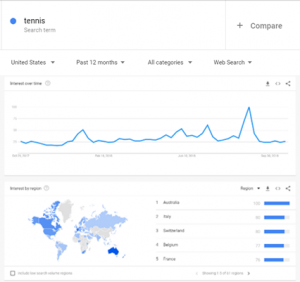What is Google Trends?
Google Trends is a free tool offered by the search engine that allows users to measure the amount of interest generated by a given search query. The Google Trends tool shows the interest over a fixed amount of time in addition to interest by region of any given query. The Query results can be filtered by location, time duration, category, or type of Google search.
Benefits of Google Trends
Because the Google Trends tool offers various ways to view how a term has shifted in popularity at a glance, it’s incredibly powerful. You can use this data to jumpstart your keyword research and better understand how to approach your digital marketing strategies–especially your SEO.
How to use Google Trends for SEO:
1) Enter Your Search Query
Consider a few of our tips before getting started.
- Try a general category–this ensures you can see a wide range of search queries including your broad topic.
- You can also search how you would with a specific keyword. Type in a more targeted term.

2) Specify Your Search with Filters
After entering your broad topic or specific search term in Google Trends, you can augment the data by implementing a few different filters, such as:
- Geographic location
- Time frame
- Type of category

3) Identify Opportunities for Tracking
Google Trends provides a series of charts on the following:
- Interest over time
- This showcases a term’s popularity over time. Popularity is measured on a scale from 0 through 100, with 100 being peak popularity.
- Interest by subregion
- This illustrates the locations in which your term was popular. You can also filter by Metro or City.
4) Utilize the Explore Function
- Under Related topics, you will find other topics users who searched your term had typed into Google. You can filter by Rising or Top topics.
- In the Related queries section, you will see other queries users who searched your term had typed into Google. Like Related topics, you can sort by Rising or Top topics.

Google Trends ultimately helps marketers find answers to the looming question: What do users search on Google? This is certainly subject to volatility depending on chosen filters. Filters such as time duration, region, and category provide incredible insights into market trends and emerging products as well as help account for seasonality. Traditionally, users enter a search query into Google Trends, and in turn Google Trends generates information pertaining to that term according to historical web search metrics.
As you’ve likely noticed, Google search results have become multi-faceted and often include videos, news items, and images alongside the web links we’re used to. It seems natural, then, for Google Trends to follow suit and allow for searches within each of these verticals – and that’s exactly what they’ve done.
One notable tool available on Google Trends is the Compare function. Compare allows marketers to dig into semantic variations and moreover compare like items. Let’s look at an example together. This image shows comparatively the global density for search and interest in Squash as shown in red, and Tennis, shown in blue. Tennis and Squash are sports of similar nature. Both are racket sports that have two players, and a ball. The volume and interest over time is drastically different. Below is an image that shows the interest by region along with the different queries for each respective term.
For tennis, the first related rising query is in fact a video game rather than a tournament or anything related to the sport. The squash category only has one search about the sport itself. The rest refer to the vegetable. These semantic differences are what markets need to learn to weed out to attract users with true intent.
How to use Google Trends to create an effective SEO Strategy
Through using Google Trends, we now determined that Tennis has a higher global search volume than squash. We also found out that much of the search volume involving squash has to do with another category with semantic similarities, the squash vegetable.
Both categories demonstrated a strong need for long tail keywords. Typically, long tail keywords are 3-4 terms in addition to a major keyword like tennis that help clarify relevancy. For example, “US open tennis 2018 results” is a much more specific query than something vague like “US tennis”.
The ultimate aim for integrating long tail keywords is to drive high converting and engaging traffic, rather than traffic for the sake of traffic. Just because a term has high search volume doesn’t necessarily mean you should chase after it. As we saw with the Squash query especially, you MUST use long tail keywords, otherwise you will have users looking for recipes rather than match results.
What does Google Trends mean for SEO?
As far as SEO and market research is concerned, Google Trends shines a light on semantic differences in keywords that can illustrate a search’s intent. It’s not enough to compile a list of keywords exactly relevant to your company anymore. To be successful one needs to incorporate the full spectrum of what your customer persona is interested in, drawn to, and looking for online. Of course, you must keep in mind that these interests change over time.
There is an immense amount of free data available, sowe recommend that you use it to your benefit. Start to untap what’s trending around you and your clients and integrate Google Trends into research and reports. To see what’s trending in the Chicagoland area, check out the Logical Media Group Chicago trends Scoreboard posts.








